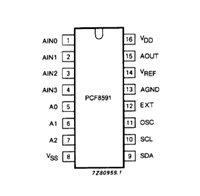R
QPRO Family of XC1700D QML Configuration PROMs
read sequentially, accessed via the internal address and bit
counters which are incremented on every valid rising edge
of CCLK.
Controlling PROMs
Connecting the FPGA device with the PROM.
•
The DATA output(s) of the PROM(s) drives the D
input of the lead FPGA device.
IN
If the user-programmable, dual-function D pin on the
IN
FPGA is used only for configuration, it must still be held at a
defined level during normal operation. Xilinx FPGAs take
care of this automatically with an on-chip default pull-up
resistor.
•
•
•
The Master FPGA CCLK output drives the CLK input(s)
of the PROM(s).
The CEO output of a PROM drives the CE input of the
next PROM in a daisy chain (if any).
Programming the FPGA With Counters
Unchanged Upon Completion
The RESET/OE input of all PROMs is best driven by
the INIT output of the lead FPGA device. This
connection assures that the PROM address counter is
reset before the start of any (re)configuration, even
When multiple FPGA-configurations for a single FPGA are
stored in a PROM, the OE pin should be tied Low. Upon
power-up, the internal address counters are reset and con-
figuration begins with the first program stored in memory.
Since the OE pin is held Low, the address counters are left
unchanged after configuration is complete. Therefore, to
reprogram the FPGA with another program, the DONE line
is pulled Low and configuration begins at the last value of
the address counters.
when a reconfiguration is initiated by a V
glitch.
CC
Other methods—such as driving RESET/OE from LDC
or system reset—assume the PROM internal
power-on-reset is always in step with the FPGA’s
internal power-on-reset. This may not be a safe
assumption.
•
•
The PROM CE input can be driven from either the LDC
or DONE pins. Using LDC avoids potential contention
This method fails if a user applies RESET during the FPGA
configuration process. The FPGA aborts the configuration
and then restarts a new configuration, as intended, but the
PROM does not reset its address counter, since it never
saw a High level on its OE input. The new configuration,
therefore, reads the remaining data in the PROM and inter-
prets it as preamble, length count etc. Since the FPGA is
the master, it issues the necessary number of CCLK pulses,
on the D pin.
IN
The CE input of the lead (or only) PROM is driven by
the DONE output of the lead FPGA device, provided
that DONE is not permanently grounded. Otherwise,
LDC can be used to drive CE, but must then be
unconditionally High during user operation. CE can
also be permanently tied Low, but this keeps the DATA
output active and causes an unnecessary supply
current of 10 mA maximum.
24
up to 16 million (2 ) and DONE goes High. However, the
FPGA configuration will be completely wrong, with potential
contentions inside the FPGA and on its output pins. This
method must, therefore, never be used when there is any
chance of external reset during configuration.
FPGA Master Serial Mode Summary
The I/O and logic functions of the Configurable Logic Block
(CLB) and their associated interconnections are established
by a configuration program. The program is loaded either
automatically upon power up, or on command, depending
on the state of the three FPGA mode pins. In Master Serial
mode, the FPGA automatically loads the configuration pro-
gram from an external memory. The Xilinx PROMs have
been designed for compatibility with the Master Serial
mode.
Cascading Configuration PROMs
For multiple FPGAs configured as a daisy-chain, or for
future FPGAs requiring larger configuration memories, cas-
caded PROMs provide additional memory. After the last bit
from the first PROM is read, the next clock signal to the
PROM asserts its CEO output Low and disables its DATA
line. The second PROM recognizes the Low level on its CE
input and enables its DATA output. See Figure 2.
Upon power-up or reconfiguration, an FPGA enters the
Master Serial mode whenever all three of the FPGA
mode-select pins are Low (M0=0, M1=0, M2=0). Data is
read from the PROM sequentially on a single data line. Syn-
chronization is provided by the rising edge of the temporary
signal CCLK, which is generated during configuration.
After configuration is complete, the address counters of all
cascaded PROMs are reset if the FPGA RESET pin goes
Low, assuming the PROM reset polarity option has been
inverted.
To reprogram the FPGA with another program, the DONE
line goes Low and configuration begins where the address
counters had stopped. In this case, avoid contention
Master Serial Mode provides a simple configuration inter-
face. Only a serial data line and two control lines are
required to configure an FPGA. Data from the PROM is
between DATA and the configured I/O use of D .
IN
DS070 (v2.1) June 1, 2000
Product Specification
www.xilinx.com
1-800-255-7778
3






 STM32F030C6芯片介绍:主要参数分析、引脚配置说明、功耗及封装
STM32F030C6芯片介绍:主要参数分析、引脚配置说明、功耗及封装

 PCF8591数据手册解读:参数、引脚说明
PCF8591数据手册解读:参数、引脚说明

 一文带你了解ss8050参数、引脚配置、应用指南
一文带你了解ss8050参数、引脚配置、应用指南

 深入解析AD7606高性能多通道模数转换器:资料手册参数分析
深入解析AD7606高性能多通道模数转换器:资料手册参数分析
